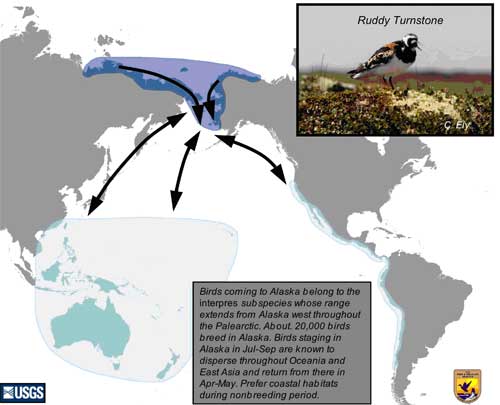Ruddy Turnstone, Arenaria i. interpres
High-Priority Species ListSampling locations: Primary sample locations include Barrow and Savoonga (St. Lawrence Island). Secondary samples may be collected at Wooley Lagoon (Seward Peninsula), Pribilof Islands, and Izembek Lagoon, with additional samples potentially collected in Hawaii.
Sampling timeframe: During May at Barrow and Savoonga and July at Barrow, focusing on municipal landfills and marine mammal boneyards. Samples from breeding birds would be obtained in June at Wooley Lagoon, an area with relatively high nesting densities of Ruddy Turnstones; additional breeding samples could likely be obtained from Barrow and Canning River. During fall staging/migration, sample locations would include the Pribilof Islands and Izembek Lagoon. Turnstones that nest in western Alaska spend the nonbreeding season in the Hawaiian Islands (P. Bruner, unpubl.), often forming large flocks. Additional samples could potentially be obtained at sites on Oahu.
Sample demographics: Adults will be sampled during migration in the spring and at breeding sites. Juveniles occur fairly regularly but in sparse numbers in autumn at coastal sites in western Alaska. Methods of capture: The sample goal of 200 can most easily be achieved through live trapping (e.g., baited walk-in trap, noose mats, mistnets) and/or collection of fecal samples from birds at sites during spring and fall migration. Smaller numbers of samples could be obtained from lethal capture (~20-40 birds).
Other targeted species: At the proposed primary sampling sites it will be possible to sample small to moderate numbers of Pacific Golden-Plovers, Bar-tailed Godwits, Long-billed Dowitchers, Dunlin, and Rock Sandpipers.
Contact: Richard Lanctot
Izembek National Wildlife Refuge (July-September, Izembek Lagoon)
Alaska Maritime National Wildlife Refuge (July, Pribilof Islands)
U.S. Geological Survey
Contact: Robert Gill
U.S. Department of Agriculture (July, Pribilof Islands)
Bamford, M., D. Watkins, W. Bancroft, and G. Tischler. 2006. Migratory shorebirds of the East Asian-Australasian Flyway: population estimates and important sites. Wetlands International Oceania. (In press).
Brown, S., C. Hickey, B. Harrington, and R. Gill, eds. 2001. The U. S. Shorebird Conservation Plan, 2nd ed. Manomet Center for Conservation Sciences. Manomet, MA.
Thompson, M. C. 1974. Migratory patterns of ruddy turnstones in the central Pacific region. Living Bird 12:5-23.

Ranking Score: 13.0
Asian H5N1 ranking criteria for Ruddy Turnstone, Arenaria i. interpres.
Total of partial contact with Asia1 |
Contact with known "hot spot"2 |
Habitat used in Asia3 |
Pop. in Alaska4 |
Can samples be obtained? |
Score |
3.0 |
2.0 |
2.5 |
2.5 |
3.0 |
13.0 |
Portion of w. Alaska nesting to s.e. & e. Asia; population nesting in Chukotka moves to w. Alaska in autumn before returning to s.e. & e. Asia |
On migration stops in c. & e. Asia (Yellow Sea, Korea, Japan) |
Breeds upland tundra; migration/nonbreeding coastal (rocky intertidal, sand beaches and mudflats) |
>35% of North American pop. (~20,000 birds) in Alaska, plus historically large numbers visit (>20,000 on Pribilof Is. From Chukotka) |
Unless postbreeding concentrations found (e.g., Pribilof Is) could be difficult to meet target sample |

